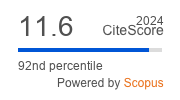ETHNICITY CLASSIFICATION USING A DYNAMIC HORIZONTAL VOTING ENSEMBLE APPROACH BASED ON FINGERPRINT
DOI:
https://doi.org/10.29284/ijasis.8.2.2022.36-47Keywords:
Biometric; deep learning; demographic; ethnicity; fingerprints.Abstract
Today, there is a fierce rivalry between ethnic groups in Nigeria on a number of issues, such as the division of power and resources, aversion to dominance, and uneven growth. Ethnicity as an identity naturally occupies a prominent position in the political arena. It is the simplest and most natural way for people to mobilize around essential human needs such as security, food, shelter, economical well-being, inequity, land distribution, autonomy, and recognition. Recent research has revealed the potential to determine an individual's ethnicity based on biometric data automatically. These studies reported significant advancements in automatically predicting demographics based on facial and iris traits. This success has been ascribed to the availability of a sufficient amount of high-quality data. There needs to be more data about the likelihood that fingerprints can disclose an individual's ethnicity. A need for more data causes this difficulty. This study aims to obtain fingerprint pictures via live scan among the major ethnic groups in Nigeria. For training and classification of the fingerprint images, the proposed Dynamic Horizontal Voting Ensemble (DHVE) deep learning with a Hybrid of Convolutional Neural Network (CNN) and Long Short-Term Memory (LSTM) as the base learner was employed. Standard performance classification metrics such as Accuracy, Recall, Precision, and F1 score were used to evaluate the performance analysis of the model. This study demonstrated an accuracy of over 98% in predicting a person's ethnicity. Additionally, the proposed model outperformed existing state-of-the-art models.
References
A. Olasunkanmi, “Ethnic Identity and Constitutional Reprentative Governance in Nigeria,” OALib, vol. 06, no. 07, 2019, pp. 1–9.
G. Martin and A. Thomson, “An Introduction to African Politics,” African Studies Review, vol. 44, no. 3, 2001. pp. 186.
F. Kush, “Precolonial Music in Nigeria,” Academia Letters, 2021.
D. Bobeldyk and A. Ross, “Predicting Soft Biometric Attributes from 30 Pixels: A Case Study in NIR Ocular Images,” IEEE Winter Applications of Computer Vision Workshops, 2019, pp. 1-9.
S. Gutta, J. R. J. Huang, P. Jonathon and H. Wechsler, “Mixture of experts for classification of gender, ethnic origin, and pose of human faces,” IEEE Transactions on Neural Networks, vol. 11, no. 4, 2000, pp. 948–960.
H. Chen, M. Gao, K. Ricanek, W. Xu and B. Fang, “A Novel Race Classification Method Based on Periocular Features Fusion,” International Journal of Pattern Recognition and Artificial Intelligence, vol. 31, no. 08, 2017, pp. 1-21.
A. Kumar, M. Prasad, S. Kumar, P. Kumari and N. Goel, “Study of fingerprint patterns among Medical students in IGIMS, Patna, Bihar,” Journal of Medical Science and Clinical Research, vol. 6, no.12, 2018, pp. 772-776.
U. U. Akpan, T. Awe, D. O. Idowu and K. O. Adekoya, “Types and frequency of fingerprint minutiae in individuals of Igbo and Yoruba ethnic groups of Nigeria,” Ruhuna Journal of Science, vol. 10, no. 1, 2019, pp. 77-87.
B. N. R. Jaja, O. Olabiyi and C. C. Noronha, “Dermatoglyphics of the Ogoni of Nigeria and its historiographic implications,” AnthropologischerAnzeiger, vol. 68, no. 2, 2011, pp. 175–183.
T. M. Otobo and R. Tarimobo-Otobo, “Digital And Palmer Dermatoglyphic Characteristics of the ijaw Ethnic Group,” International Journal of Forensic Medical Investigation, vol. 2, no. 1, 2016, pp. 25-30.
A. B. Owolabi, “Ethnic Identity, Social Class and Consumption Pattern Among Three Major Ethnic Groups in Nigeria,” Advances in Social Sciences Research Journal, vol. 1, no. 5, 2014, pp. 149–159.
E. J. Jaiyeoba-Ojigho, I. E. Odokuma and P. S. Igbigbi, “Comparative Study of Fingerprint Patterns of Two Ethnic Groups: A Nigerian Study,” Journal of College of Medical Sciences-Nepal, vol. 15, no. 4, 2019, pp. 270–275.
H. O. Aworinde, A. O. Afolabi, A. S. Falohun and O. T. Adedeji, “Performance Evaluation of Feature Extraction Techniques in Multi-Layer Based Fingerprint Ethnicity Recognition System,” Asian Journal of Research in Computer Science, 2019, pp. 1–9.
E. M. Agwu, “Lifestyle Behaviours, Among University Students in Nigeria by Gender and Ethnicity,” RA Journal of Applied Research, vol. 04, no. 06, 2018, pp. 1746-1756.
A. H. Oluwatobi and O.F.W. Onifade, “A Soft Computing Model of Soft Biometric Traits for Gender and Ethnicity Classification,” International Journal of Engineering and Manufacturing, vol. 9, no. 2, 2019, pp. 54–63.
D. Giveki, “Improving the Performance of Convolutional Neural Networks for Image Classification,” Optical Memory and Neural Networks, vol. 30, no. 1, 2021, pp. 51–66.
B. Rim, J. Kim and M. Hong, “Gender classification from fingerprint images using deep learning approach,” Proceedings of the International Conference on Research in Adaptive and Convergent Systems, 2020, pp. 7-12.
B. Pandya, G. Cosma, A. A. Alani, A. Taherkhani, V. Bharadi and T. M. McGinnity, “Fingerprint classification using a deep convolutional neural network,” 4th International Conference on Information Management, 2018. pp. 86-91.
Z. Xuan, H. Liu, C. Li, and Y. Liu, “Wavelet Bilateral Filter Algorithm-Based High-Frequency Ultrasound Image Analysis on Effects of Skin Scar Repair,” Scientific Programming, vol. 2021, 2021. pp. 1–7.
Downloads
Published
Issue
Section
License
Copyright (c) 2022 Olorunsola Stephen Olufunso, Abraham E. Evwiekpaefe & Martins E. Irhebhude

This work is licensed under a Creative Commons Attribution 4.0 International License.
This work is licensed under a Creative Commons Attribution 4.0 International License, which permits unrestricted use, distribution, and reproduction in any medium, provided the original work is properly cited.











